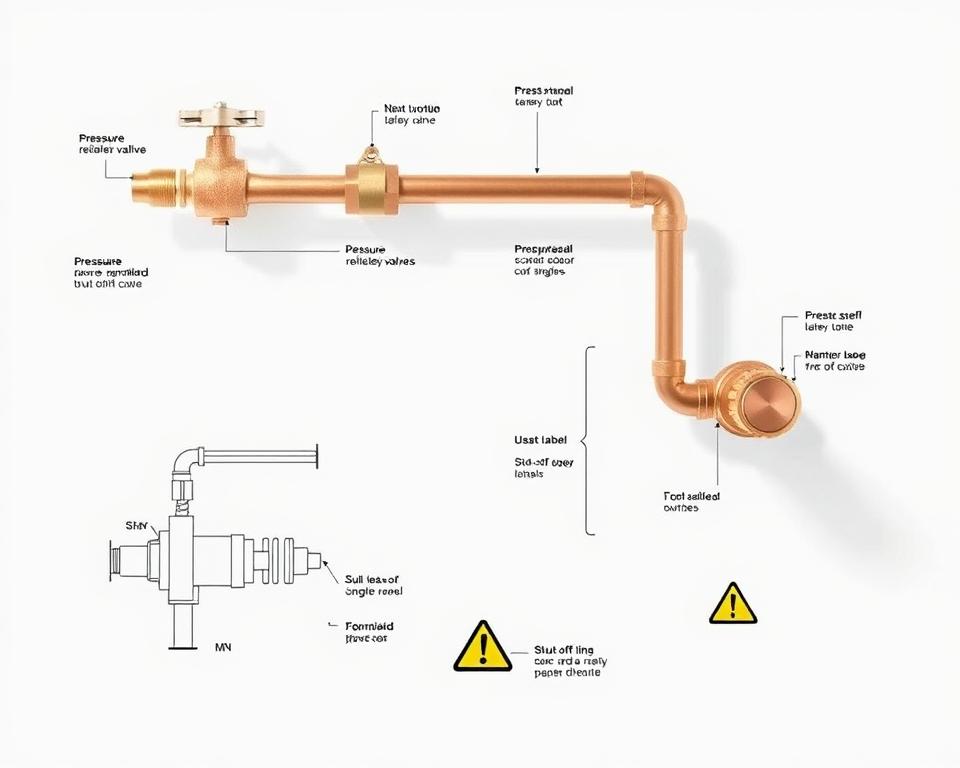Copper Gas Line Installation & Protection Guide
Did you know approximately 90% of supply shops provide cutting services for and thread black iron metal piping at a supplementary cost? Such information demonstrates the strong demand and easy access to gas piping materials, especially copper gas lines. Many homes now opt for copper for its durability, reliability, and corrosion resistance. This guide will examine the essentials of copper gas lines, their advantages, and critical safety measures for installation. With insights from Installation Parts Supply, you’ll learn key elements of gas line installation. This knowledge ensures both safety and adherence to codes while fulfilling your gas piping needs.
Important Takeaways
- Copper gas lines deliver robustness and corrosion resistance.
- Installation necessitates correct sizing and following local code regulations.
- Safety measures are critical to guarantee leak-proof gas lines.
- Comprehending the accurate routing and positioning is crucial for successful setup.
- Routine upkeep helps in prolonging the durability of copper gas lines.
Grasping the Basics of Copper Gas Lines
Copper gas lines are widely used in both residential and business settings. They’re esteemed for security and dependability. Learning about type l copper wall thickness, including their advantages and how they stack up against other materials, is essential. This understanding enables homeowners to decide wisely.
How would you define a Copper Gas Line?
A copper gas line uses copper piping for natural gas and propane distribution. It meets established codes like the National Fuel Gas Code (NFPA 54/ANSI Z223.1). In regions like Minnesota and Florida, it ranks as the leading option in home fuel gas piping. From 1999 onward, agencies such as IAPMO have endorsed its use in fuel gas systems.
Merits of Utilizing Copper Gas Lines
Copper gas lines provide several key benefits. They include:
- Corrosion Resistance: Copper outshines steel and black iron in combating corrosion.
- Flexibility: The pliability eases installation, even in complex layouts.
- Durability: Copper gas lines offer long life and robust construction, thus requiring less frequent replacement.
- Safety: Following stringent protocols, copper tubing proves reliable in gas distribution.
Comparison with Other Materials
In comparing copper and steel for gas lines, copper often dominates. Black iron pipes are still common, especially in cities like Chicago. Even so, copper’s lightweight nature and ease of handling have increased its usage. Although roughly 50% of gas companies have switched to stainless steel owing to regulations, copper’s advantages hold strong in certain situations. This is especially true in areas like St. Louis, where newer homes frequently feature copper gas lines.
| Supplies Needed | Tools for Copper Gas Line Installation |
|---|---|
| Copper pipes (Type K and Type L) | Pipe wrenches |
| Couplings and fixtures | Copper cutter |
| Plumber’s sealing tape | Soldering kit |
| Protective equipment (gloves, goggles) | Gauge |
Optimal Methods for Copper Gas Line Fitting
Installing copper gas lines involves certain optimal methods to uphold security and effectiveness. Key aspects of the process include accurate planning of routes, firm attachments, and rigorous leak tests. These measures ensure a gas piping system that is both safe and compliant.
Placement and Routing for Copper Gas Lines
Thoughtful planning is crucial when routing copper gas lines. It is necessary to keep these lines away from structural features that could inflict harm. Such an approach avoids electrochemical corrosion by preventing contact with dissimilar metals. Also, ensuring readily accessible routes for future upkeep and fixes is essential by maintaining clearances.
Adhering to these placement and routing standards enhances the system’s security and durability.
Connecting and Sealing Pipes Properly
Making firm attachments in copper gas pipes necessitates specific materials. Use gas-grade plumber’s tape and gas-specific sealants only. Steer clear of regular thread seal tape to prevent leaks from thread oils. By adhering to proper attachment and sealing methods, the chance of gas leaks is markedly diminished, aligning with safety and regulatory requirements.
Testing for Leaks Post-Installation
Post-installation, performing an exhaustive leak inspection is vital. Start with a pressure test, applying 1.5 times the system’s maximum working pressure for no less than 10 minutes. Alternatively, you may apply soapy water to expose leaks if bubbles form. The target pressure for these tests should be approximately 9 inches w.c., with a slight variance allowed. These methods of leak detection are fundamental in ensuring the safety of the gas system, which protects both property and lives.
Copper Gas Line Safety Regulations
Understanding and following the multiple regulations and codes is vital for copper gas line safety. These rules ensure compliance and reduce risks such as leaks and failures. Both residents and professionals need to rigorously observe local building codes. They are required to secure the necessary permits before initiating any installation projects.
Understanding Local Code Requirements
Local building codes set the guidelines for installing copper gas lines. They address issues like installation depth, needed support structures, and corrosion prevention measures. For underground pipes, there is usually a stipulation for 18 inches of cover. However, in some cases, this can be lowered to 12 inches. Metal sleeves are also often required for copper tubing that passes through wall plates near exposed edges.
Review and Adherence
Regular examinations by qualified experts are essential for gas line safety. They ensure that installations adhere to both the National Fuel Gas Code and local building codes. These evaluations assess whether copper pipes are secured properly and if holes made in joists are the correct size. Adhering to these criteria improves safety and guarantees dependable function of gas line installations over time.
Addressing Common Concerns with Copper Gas Lines
Copper gas lines, renowned for their longevity, can experience corrosion problems. It’s vital to understand possible issues and necessary upkeep to guarantee safety. Recognizing corrosion signs and the advantages of upkeep can prevent gas leaks. This knowledge combined with a comparison between copper and steel gas lines assists in selecting the optimal material.
Copper Gas Line Corrosion Issues
Over time, copper gas lines may corrode due to environmental factors or installation errors. Telltale signs include discoloration, peeling, and surprising increases in gas bills. Such damage can cause gas leaks, indicated by a rotten egg smell from added mercaptan. After building or digging, inspecting for noticeable damage is crucial.
Upkeeping Your Copper Gas Line
For safety and efficiency, upkeeping copper gas lines is critical. Annual inspections can detect early corrosion and issues. Ensuring appliances remain clean and properly ventilated prevents accumulation of gas and risks of carbon monoxide poisoning. Only certified professionals should manage repairs and installations, ensuring safety code compliance and minimizing risks of failure.
Copper Gas Line vs. Steel: Pros and Cons
Deciding between copper and steel gas lines requires evaluating advantages and disadvantages. Copper’s flexibility simplifies setup in confined areas and typically offers better corrosion resistance. In comparison, steel lines may offer greater longevity and be more economical for some projects. Considering these aspects aids in choosing the right material for your needs.
To Summarize
The importance of following optimal methods for copper gas line installation is paramount. Adherence to safety standards and local codes guarantees effective performance and security. The manual also highlights copper gas lines’ advantages, such as durability and rust resistance. However, it’s imperative to remain informed about material-related developments.
Maintenance is critical to the durability and performance of copper gas lines. Proper installation and routine evaluations reduce the likelihood of corrosion and system failures. Being informed about local code changes is imperative to prevent penalties or expensive fixes for non-compliance.
Opt for expert advice for copper gas line projects as it is greatly beneficial. Installation Parts Supply supplies extensive knowledge and support. They guarantee your project meets all safety standards, boosting your system’s security and dependability.
Frequently Asked Questions
How would you define a copper gas line?
A copper gas line is a type of piping for gas distribution. It’s made from copper. This substance is chosen for its longevity, flexibility, and ability to resist corrosion. These properties make it well-suited for home gas installations.
What advantages do copper gas lines offer?
Copper gas lines offer remarkable corrosion resistance and flexibility. They are simpler to set up than other substances. Their extended durability and safety features make them ideal for gas distribution systems.
How do copper gas lines compare to steel or black iron pipes?
Copper gas lines surpass steel and black iron pipes in several ways. They are more resistant to corrosion and are lighter and easier to handle. Due to these benefits, they are less prone to leakage, making them a favored option for many experts.
What preparations are necessary for copper gas line installation?
Before installing, you should secure local permits and grasp gas flow dynamics. Thorough planning ensures a secure, code-adherent setup.
Which tools and supplies are needed for copper gas line installation?
You’ll need copper pipes, couplings and fixtures, and plumber’s tape. Pipe wrenches, safety gear, and gas-grade sealants are also essential. These materials ensure secure connections.
What are the best practices for routing and positioning copper gas lines?
Ensure that the gas lines are kept away from structural elements and dissimilar metals. Adequate support systems are essential to avoid galvanic corrosion.
How do I properly connect and seal copper gas pipes?
Securely connect and close pipes using gas-grade plumber’s tape and sealants. Always double-check your work to prevent leaks.
What methods can be used to detect leaks post-installation of copper gas lines?
Perform leak inspections with a soapy water solution, checking for bubbles. Pressure testing helps ensure the system’s integrity.
What are the key safety regulations for copper gas line installation?
Adhere to local building codes, verify proper installation depth, and secure the necessary permits. Professional inspections are also required.
What corrosion problems are typically found in copper gas lines?
Corrosion may develop from contact with different metals or external conditions. Prevent this by using correct installation methods and performing regular maintenance.
How can I maintain my copper gas line?
Maintain your lines with regular inspections, cleaning, and upkeep. This averts corrosion and leaks, promoting a long lifespan.
Under what conditions is a copper gas line preferable to steel?
Opt for copper for residential use due to its flexibility and low corrosion risk. Steel is more appropriate for high-pressure, industrial settings.



